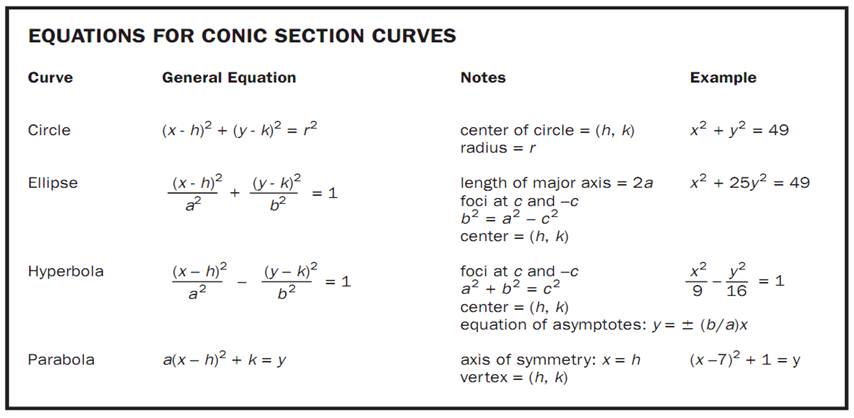


 تاريخ الرياضيات
تاريخ الرياضيات
 الرياضيات في الحضارات المختلفة
الرياضيات في الحضارات المختلفة 
 الرياضيات المتقطعة
الرياضيات المتقطعة
 الجبر
الجبر
 الهندسة
الهندسة 
 المعادلات التفاضلية و التكاملية
المعادلات التفاضلية و التكاملية 
 التحليل
التحليل
 علماء الرياضيات
علماء الرياضيات |
Read More
Date: 5-1-2016
Date: 11-1-2016
Date: 7-1-2016
|
Imagine there are two cone-shaped paper drinking cups, each fastened to the other at its point, or vertex. The figure that would result is described mathematically as a right circular cone (sometimes called a double cone), which is formed by a straight line that moves around the circumference of a circle while passing through a fixed point (the vertex) that is not in the plane of the circle.
If a right circular cone is cut, or intersected, by a plane at different locations, the intersections form a family of plane curves called conic sections (see the figure). If the intersecting plane is parallel to the base of the cone, the intersection is a circle—which shrinks to a point when the plane has moved toward the cone’s tip and finally passes through the vertex. If the intersecting plane is not parallel to the base, passes through only one half of the cone, and is not parallel to the side of the cone, then the intersection is an ellipse. If the plane intersects both halves of the cone, and is not par-

allel to the side of the cone, then the intersection is a curve that has two branches, called a hyperbola. If the plane intersects the cone so that the plane is parallel to the side of the cone, then the intersection is a curve called a parabola. The equations for the conic section curves can have the general forms summarized in the table.

These conic section curves—the circle, ellipse, hyperbola, and parabola—have been known and named for more than 2,000 years, and they occur in many applications. The path of a thrown ball, the arc of cables that support a bridge, and the arc of a fountain are examples of parabolas. The shape of a sonic boom, the path of comets, and the LORAN navigation system for ships involve the hyperbola. The paths traveled by the planets, domeshaped ceilings, and the location of the listening points in a whispering gallery involve the ellipse. Of course, examples of the most familiar conic section—the circle—can be found everywhere: the shape of flowers, ripples in a pool, and water-worn stones.
______________________________________________________________________________________________
Reference
Jacobs, Harold R. Mathematics, A Human Endeavor. San Francisco: W.H. Freeman and Company, 1970.



|
|
|
|
منها نحت القوام.. ازدياد إقبال الرجال على عمليات التجميل
|
|
|
|
|
|
|
دراسة: الذكاء الاصطناعي يتفوق على البشر في مراقبة القلب
|
|
|
|
|
|
|
هيئة الصحة والتعليم الطبي في العتبة الحسينية تحقق تقدما بارزا في تدريب الكوادر الطبية في العراق
|
|
|